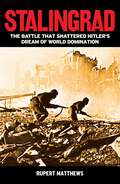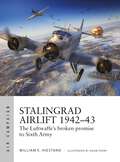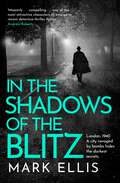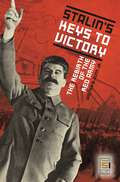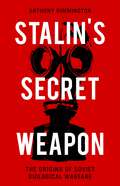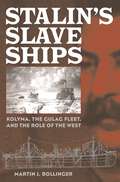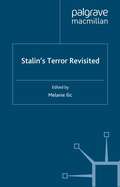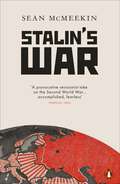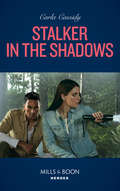- Table View
- List View
Stalingrad: The City that Defeated the Third Reich
by Jochen Hellbeck Translated by Christopher Tauchen Dominic BonfiglioJust days after the Germans surrendered at Stalingrad, legendary Red Army sniper Vasily Zaytsev described the horrors he witnessed during the five-month long conflict: "one sees the young girls, the children who hang from trees in the park... I have unsteady nerves and I'm constantly shaking.”He was being interviewed, along with 214 other men and women-soldiers, officers, civilians, administrative staffers and others-amidst the rubble that remained of Stalingrad by members of Moscow's Historical Commission. Sent by the Kremlin, their aim was to record a comprehensive, historical documentary of the tremendous hardships overcome and heroic triumphs achieved during the battle.20 soldiers of the 38th Rifle Division vividly recount how they stumbled upon the commander of the German troops, Field Marshal Friederich Paulus, defeated and hiding in a bed that reeked like a latrine. A lieutenant colonel remembers the brave 20 year-old adjutant who wrapped his arms around his commander's body to protect him from a flying grenade. Working around the clock, Nurse Vera Gurova describes a 24 hour period during which her hospital received over than 600 wounded men - equivalent to one every two and an half minutes. Countless soldiers endured shrapnel wounds and received blood transfusions in the trenches, but she can't forget the young amputee who begged her to avenge his suffering at Stalingrad.This harrowing montage of distinct voices was so candid that the Kremlin forbade its publication and consigned the bulk of these documents to a Moscow archive where they remained forgotten for decades, until now. Jochen Hellbeck's Stalingrad is a definitive portrait of perhaps the greatest urban battle of the Second World War-a pivotal moment in the course of the war re-created with absolute candor and chilling veracity by the voices of the men and women who fought there.
Stalingrad: The Battle that Shattered Hitler's Dream of World Domination
by Rupert MatthewsPerhaps it was Adolf Hitler's implacable hatred of Soviet dictator Joseph Stalin that compelled the Fu¨hrer to order the taking, whatever the cost, of the city that bore his enemy's name. The bloody battle that ensued proved one thing at least to historians: when an irresistible force meets an immoveable object the result is carnage, and in this case the reduction of a vast city to a landscape of rubble and ruins.The bitter Battle of Stalingrad on the Eastern Front was the turning point of World War II. The relentless and unstoppable German advances that had seen the panzers sweep hundreds of miles into Russia were finally brought to a halt. The elite German 6th Army was first fought to a standstill, then surrounded and forced to surrender.Over 1.5 million people lost their lives during the six months of fighting, many of them civilians caught up in the campaign. For the first time in the war, the German army had been defeated on the field of battle. Before Stalingrad the Russians never won; after Stalingrad they could not lose.This book looks at the titanic struggle that ended in the total destruction of the second city of the Soviet Union, the greatest battle the world has ever seen.
Stalingrad 1942–43: The German Advance to the Volga (Campaign)
by Robert ForczykAfter failing to defeat the Soviet Union with Operation Barbarossa in 1941, Adolf Hitler planned a new campaign for the summer of 1942 that was intended to achieve a decisive victory: Operation Blue (Case Blau). In this new campaign, Hitler directed that one army group (Heeresgruppe A) would advance to seize the Soviet oilfields in the Caucasus, while the other (Heeresgruppe B) pushed on to the Volga River. The expectation was for a rapid victory – instead, German forces had to fight hard just to reach the outskirts of Stalingrad, and then found themselves embroiled in a protracted urban battle amid the ruins of a devastated city on the Volga. The Soviet Red Army was hit hard by the initial German offensive but held onto the city and then launched Operation Uranus, a winter counteroffensive that encircled the German 6. Armee at Stalingrad. Despite a desperate German relief operation, the Red Army eventually crushed the German forces and hurled the remnants of the German southern front back in disorder. This first volume in the Stalingrad trilogy covers the period from 28 June to 11 September 1942, including operations around Voronezh. The fighting in the Don Bend, which lasted weeks, comprised some of the largest tank battles of World War II – involving more armour than the tanks employed at Prokhorovka in 1943.
Stalingrad 1942–43: The Fight for the City (Campaign)
by Robert ForczykThe second in a three-part series examining the Stalingrad campaign, one of the most decisive military operations in World War II, that set the stage for the ultimate defeat of the Third Reich.By early September 1942, 6.Armee and 4.Panzer-Armee had reached the outskirts of Stalingrad, and Hitler believed it was about to fall. He ordered for the capture of the city as soon as possible, but this was easier said than done. On 13 September, a direct German assault was launched against the city on the Volga and a protracted urban battle followed amid the ruins, already devastated by massive Luftwaffe raids. Although hit hard by the initial German offensive, a ruthless and obstinate Red Army was able to hold onto the city through a costly battle of attrition that sacrificed huge amounts of men and materiel. This second volume in the Stalingrad trilogy, written by a leading expert on the military history of the Eastern Front, brings the fighting in the city to life in full visual detail, including the iconic battles at the Krasny Oktyabr Steel Plant, the Grain Elevator, the Barrikady and STZ factories, the 'Tennis Racquet' and Rynok–Spartanovka. Drawing from sources on both sides, this book offers a truly comprehensive account of history's greatest urban battle.
Stalingrad 1942–43: The Fight for the City (Campaign)
by Robert ForczykThe second in a three-part series examining the Stalingrad campaign, one of the most decisive military operations in World War II, that set the stage for the ultimate defeat of the Third Reich.By early September 1942, 6.Armee and 4.Panzer-Armee had reached the outskirts of Stalingrad, and Hitler believed it was about to fall. He ordered for the capture of the city as soon as possible, but this was easier said than done. On 13 September, a direct German assault was launched against the city on the Volga and a protracted urban battle followed amid the ruins, already devastated by massive Luftwaffe raids. Although hit hard by the initial German offensive, a ruthless and obstinate Red Army was able to hold onto the city through a costly battle of attrition that sacrificed huge amounts of men and materiel. This second volume in the Stalingrad trilogy, written by a leading expert on the military history of the Eastern Front, brings the fighting in the city to life in full visual detail, including the iconic battles at the Krasny Oktyabr Steel Plant, the Grain Elevator, the Barrikady and STZ factories, the 'Tennis Racquet' and Rynok–Spartanovka. Drawing from sources on both sides, this book offers a truly comprehensive account of history's greatest urban battle.
Stalingrad 1942–43: The German Advance to the Volga (Campaign #359)
by Robert ForczykAfter failing to defeat the Soviet Union with Operation Barbarossa in 1941, Adolf Hitler planned a new campaign for the summer of 1942 that was intended to achieve a decisive victory: Operation Blue (Case Blau). In this new campaign, Hitler directed that one army group (Heeresgruppe A) would advance to seize the Soviet oilfields in the Caucasus, while the other (Heeresgruppe B) pushed on to the Volga River. The expectation was for a rapid victory – instead, German forces had to fight hard just to reach the outskirts of Stalingrad, and then found themselves embroiled in a protracted urban battle amid the ruins of a devastated city on the Volga. The Soviet Red Army was hit hard by the initial German offensive but held onto the city and then launched Operation Uranus, a winter counteroffensive that encircled the German 6. Armee at Stalingrad. Despite a desperate German relief operation, the Red Army eventually crushed the German forces and hurled the remnants of the German southern front back in disorder. This first volume in the Stalingrad trilogy covers the period from 28 June to 11 September 1942, including operations around Voronezh. The fighting in the Don Bend, which lasted weeks, comprised some of the largest tank battles of World War II – involving more armour than the tanks employed at Prokhorovka in 1943.
Stalingrad 1942–43: Catastrophe: the Death of 6.Armee (Campaign)
by Robert ForczykThe final part in a three-book series on the Battle of Stalingrad, examining the Soviet encirclement, German relief efforts, and the final surrender of Paulus' 6.Armee.Having fought hard just to reach the outskirts of Stalingrad, the Axis forces found themselves embroiled in a protracted urban battle amid the ruins of a devastated city on the Volga. The Soviet Red Army was able to hold onto the city then mount a surprise winter counter-offensive known as Operation Uranus, which succeeded in encircling the German 6.Armee at Stalingrad. Despite a desperate German relief operation, the Red Army eventually crushed the 6.Armee and hurled the remnants of the German southern front back in disorder. This third and final volume in the Stalingrad trilogy begins just after the German 6.Armee has been isolated at Stalingrad, and covers the period from 24 November 1942 to 2 February 1943. The specially commissioned maps and 3D diagrams guide the reader in step-by-step, easily to follow detail through the German relief operation (Wintergewitter), the fighting on the Chir River, and the Soviet operations Koltso and Little Saturn, and are complimented by the battlescene artworks that vividly depict the harsh conditions experienced by the common soldiers fighting on both sides.
Stalingrad 1942–43: Catastrophe: the Death of 6.Armee (Campaign)
by Robert ForczykThe final part in a three-book series on the Battle of Stalingrad, examining the Soviet encirclement, German relief efforts, and the final surrender of Paulus' 6.Armee.Having fought hard just to reach the outskirts of Stalingrad, the Axis forces found themselves embroiled in a protracted urban battle amid the ruins of a devastated city on the Volga. The Soviet Red Army was able to hold onto the city then mount a surprise winter counter-offensive known as Operation Uranus, which succeeded in encircling the German 6.Armee at Stalingrad. Despite a desperate German relief operation, the Red Army eventually crushed the 6.Armee and hurled the remnants of the German southern front back in disorder. This third and final volume in the Stalingrad trilogy begins just after the German 6.Armee has been isolated at Stalingrad, and covers the period from 24 November 1942 to 2 February 1943. The specially commissioned maps and 3D diagrams guide the reader in step-by-step, easily to follow detail through the German relief operation (Wintergewitter), the fighting on the Chir River, and the Soviet operations Koltso and Little Saturn, and are complimented by the battlescene artworks that vividly depict the harsh conditions experienced by the common soldiers fighting on both sides.
Stalingrad Airlift 1942–43: The Luftwaffe's broken promise to Sixth Army (Air Campaign)
by William E. HiestandThe story of what really led to Germany losing the battle of Stalingrad - the inability of the Luftwaffe to keep Sixth Army supplied throughout the winter of 1942–43 - and why this crucial airlift failed.Luftwaffe chief Hermann Goering's failure to deliver his promise to keep Sixth Army supplied at Stalingrad was one of the most hard-hitting strategic air failures of World War II. 300 tons a day of supplies were required to sustain the Sixth Army, flown in against a Soviet fighter force whose capabilities were rapidly being transformed. The Luftwaffe's failure left Sixth Army trapped, vulnerable and too weak to attempt a breakout. The destruction of Sixth Army was one of the major turning points in World War II but the Luftwaffe's crucial role in this disaster has often been overlooked. Some claim the attempt was doomed from the beginning but, in this intriguing book, author William E. Hiestand explains how the Germans had amassed sufficient aircraft to, at least theoretically, provide the supplies needed. Demands of aircraft maintenance, awful weather and, in particular, the Soviet air blockade crippled the airlift operation. In addition, the employment of increasing numbers of modern aircraft by the Soviet Air Force using more flexible tactics, coupled with Chief Marshal Novikov's superior Air Army organisation proved decisive. The Luftwaffe did eventually recover and mounted focused operations for control of limited areas of the Eastern Front, but overall it had lost its dominance. Packed with strategic diagrams and maps, archive photos and artwork of aerial battles over Stalingrad, and including bird's eye views of Operation Winter Storm and airlift operations and tactics, this title clearly demonstrates how the Luftwaffe lost its strategic initiative in the air.
Stalingrad Airlift 1942–43: The Luftwaffe's broken promise to Sixth Army (Air Campaign)
by William E. HiestandThe story of what really led to Germany losing the battle of Stalingrad - the inability of the Luftwaffe to keep Sixth Army supplied throughout the winter of 1942–43 - and why this crucial airlift failed.Luftwaffe chief Hermann Goering's failure to deliver his promise to keep Sixth Army supplied at Stalingrad was one of the most hard-hitting strategic air failures of World War II. 300 tons a day of supplies were required to sustain the Sixth Army, flown in against a Soviet fighter force whose capabilities were rapidly being transformed. The Luftwaffe's failure left Sixth Army trapped, vulnerable and too weak to attempt a breakout. The destruction of Sixth Army was one of the major turning points in World War II but the Luftwaffe's crucial role in this disaster has often been overlooked. Some claim the attempt was doomed from the beginning but, in this intriguing book, author William E. Hiestand explains how the Germans had amassed sufficient aircraft to, at least theoretically, provide the supplies needed. Demands of aircraft maintenance, awful weather and, in particular, the Soviet air blockade crippled the airlift operation. In addition, the employment of increasing numbers of modern aircraft by the Soviet Air Force using more flexible tactics, coupled with Chief Marshal Novikov's superior Air Army organisation proved decisive. The Luftwaffe did eventually recover and mounted focused operations for control of limited areas of the Eastern Front, but overall it had lost its dominance. Packed with strategic diagrams and maps, archive photos and artwork of aerial battles over Stalingrad, and including bird's eye views of Operation Winter Storm and airlift operations and tactics, this title clearly demonstrates how the Luftwaffe lost its strategic initiative in the air.
Stalinism and the Soviet-Finnish War, 1939–40: Crisis Management, Censorship and Control (St Antony's Series)
by Malcolm L. SpencerThis book offers an illuminating bridge between the political and social dimensions of the Soviet-Finnish War of 1939-40. The conflict represented a significant crisis for the Soviet Union, inspiring international condemnation and a significant loss of face for its supporters, both at home and abroad. The focus of this study is not upon the military dynamics of the war, but upon its ability to influence events, interpretations and interactions between agents and institutions within the Soviet Union and the wider international communist movement. Through original archival research, this book considers the ways in which the Soviet leadership reacted to the crisis, the tools at its disposal, and the effectiveness with which it managed to manipulate and control the spread of information through official and unofficial channels. It contributes to a more complete and complex picture of the inter-related nature of Soviet politics, propaganda and mass media in this period.
Stalinism and the Soviet-Finnish War, 1939–40: Crisis Management, Censorship and Control (St Antony's Series)
by Malcolm L. SpencerThis book offers an illuminating bridge between the political and social dimensions of the Soviet-Finnish War of 1939-40. The conflict represented a significant crisis for the Soviet Union, inspiring international condemnation and a significant loss of face for its supporters, both at home and abroad. The focus of this study is not upon the military dynamics of the war, but upon its ability to influence events, interpretations and interactions between agents and institutions within the Soviet Union and the wider international communist movement. Through original archival research, this book considers the ways in which the Soviet leadership reacted to the crisis, the tools at its disposal, and the effectiveness with which it managed to manipulate and control the spread of information through official and unofficial channels. It contributes to a more complete and complex picture of the inter-related nature of Soviet politics, propaganda and mass media in this period.
Stalinism at War: The Soviet Union in World War II
by Mark EdeleStalinism at War tells the epic story of the Soviet Union in World War Two. Starting with Soviet involvement in the war in Asia and ending with a bloody counter-insurgency in the borderlands of Ukraine, Belarus and the Baltics, the Soviet Union's war was both considerably longer and more all-encompassing than is sometimes appreciated. Here, acclaimed scholar Mark Edele explores the complex experiences of both ordinary and extraordinary citizens – Russians and Koreans, Ukrainians and Jews, Lithuanians and Georgians, men and women, loyal Stalinists and critics of his regime – to reveal how the Soviet Union and leadership of a ruthless dictator propelled Allied victory over Germany and Japan. In doing so, Edele weaves together material on the society and culture of the wartime years with high-level politics and unites the military, economic and political history of the Soviet Union with broader popular histories from below. The result is an engaging, intelligent and authoritative account of the Soviet Union from 1937 to 1949.
Stalinism at War: The Soviet Union in World War II
by Mark EdeleStalinism at War tells the epic story of the Soviet Union in World War Two. Starting with Soviet involvement in the war in Asia and ending with a bloody counter-insurgency in the borderlands of Ukraine, Belarus and the Baltics, the Soviet Union's war was both considerably longer and more all-encompassing than is sometimes appreciated. Here, acclaimed scholar Mark Edele explores the complex experiences of both ordinary and extraordinary citizens – Russians and Koreans, Ukrainians and Jews, Lithuanians and Georgians, men and women, loyal Stalinists and critics of his regime – to reveal how the Soviet Union and leadership of a ruthless dictator propelled Allied victory over Germany and Japan. In doing so, Edele weaves together material on the society and culture of the wartime years with high-level politics and unites the military, economic and political history of the Soviet Union with broader popular histories from below. The result is an engaging, intelligent and authoritative account of the Soviet Union from 1937 to 1949.
Stalin's American Spy: Noel Field, Allen Dulles and the East European Show-Trials
by Tony SharpStalin's American Spy tells the remarkable story of Noel Field, a Soviet agent in the US State Department in the mid-1930s. Lured to Prague in May 1949, he was kidnapped and handed over to the Hungarian secret police. Tortured by them and interrogated too by their Soviet superiors, Field's forced 'confessions' were manipulated by Stalin and his East European satraps to launch a devastating series of show-trials that led to the imprisonment and judicial murder of numerous Czechoslovak, German, Polish and Hungarian party members. Yet there were other events in his very strange career that could give rise to the suspicion that Field was an American spy who had infiltrated the Communist movement at the behest of Allen Dulles, the wartime OSS chief in Switzerland who later headed the CIA. Never tried, Field and his wife were imprisoned in Budapest until 1954, then granted political asylum in Hungary, where they lived out their sterile last years. This new biography takes a fresh look at Field's relationship with Dulles, and his role in the Alger Hiss affair. It sheds fresh light upon Soviet espionage in the United States and Field's relationship with Hede Massing, Ignace Reiss and Walter Krivitsky. It also reassesses how the increasingly anti-Semitic East European show-trials were staged and dissects the 'lessons" which Stalin sought to convey through them.
Stalin's American Spy: Noel Field, Allen Dulles and the East European Show-Trials
by Tony SharpStalin's American Spy tells the remarkable story of Noel Field, a Soviet agent in the US State Department in the mid-1930s. Lured to Prague in May 1949, he was kidnapped and handed over to the Hungarian secret police. Tortured by them and interrogated too by their Soviet superiors, Field's forced 'confessions' were manipulated by Stalin and his East European satraps to launch a devastating series of show-trials that led to the imprisonment and judicial murder of numerous Czechoslovak, German, Polish and Hungarian party members. Yet there were other events in his very strange career that could give rise to the suspicion that Field was an American spy who had infiltrated the Communist movement at the behest of Allen Dulles, the wartime OSS chief in Switzerland who later headed the CIA. Never tried, Field and his wife were imprisoned in Budapest until 1954, then granted political asylum in Hungary, where they lived out their sterile last years. This new biography takes a fresh look at Field's relationship with Dulles, and his role in the Alger Hiss affair. It sheds fresh light upon Soviet espionage in the United States and Field's relationship with Hede Massing, Ignace Reiss and Walter Krivitsky. It also reassesses how the increasingly anti-Semitic East European show-trials were staged and dissects the 'lessons" which Stalin sought to convey through them.
Stalin's Commandos: Ukrainian Partisan Forces on the Eastern Front
by Alexander GogunAt the height of World War II, a large number of Soviet partisans fought on the Eastern Front against the Axis occupation. In this book, Alexander Gogun looks at the forces operating in Ukraine. The Nazi atrocities were often matched by partisan brutality. The author examines the indiscriminate use of scorched-earth tactics by the partisans, the destruction of their own villages, partisan-generated Nazi reprisals against civilians, and the daily incidents of robbery, drunkenness, rape and bloody internal conflicts that were reported to be widespread amongst the red partisans. Gogun also analyses allegations of the use of bacteriological weapons and even instances of cannibalism. He shows that all these practices were not a product of the culture of warfare nor a spontaneous 'people's response' to the unremitting brutality of Nazi rule but a specific feature of Stalin's total war strategy.
Stalin's Gold: A Dci Frank Merlin Novel (The DCI Frank Merlin Series #2)
by Mark EllisDecember 1938. Moscow. Josef Stalin has lost some gold. He is not a happy man. He asks his henchman Beria to track it down. September 1940 London. Above the city the Battle of Britain rages and the bombs rain down. On the streets below, DCI Frank Merlin and his officers investigate the sudden disappearance of Polish RAF pilot Ziggy Kilinski while also battling an epidemic of looting unleashed by the chaos and destruction of the Blitz. Kilinski's fellow pilots, a disgraced Cambridge don, Stalin's spies in London, members of the Polish government in exile and a ruthless Russian gangster are amongst those caught up in Merlin's enquiries. Sweeping from Stalin's Russia to Civil War Spain, from Aztec Mexico to pre-war Poland, and from Hitler's Berlin to Churchill's London a compelling story of treasure, grand larceny, treachery, torture and murder unfolds. Eventually as Hitler reluctantly accepts that the defiance of the RAF has destroyed his chances of invasion for the moment, a violent shoot-out in Hampstead leads Merlin on the final truth....and Stalin to his gold. Stalin's Gold is the latest in the Frank Merlin Series, and follows on from Princes Gate.
Stalin's Keys to Victory: The Rebirth of the Red Army (Praeger Security International)
by Walter S. Jr.Most military historians have difficulty comprehending the miracle that took place in late 1941 and early 1942 in the Soviet Union. In the summer of 1941, the German Army routed the Red Army as it had routed the Polish, British, French and other armies in 1939, 1940, and early 1941. None had been able to withstand German might more than a few weeks. When Hitler invaded the Soviet Union in June 1941, his legions quickly overcame the Soviet divisions they met, and it appeared to most that Hitler would succeed as he had before. A major portion of the prewar Red Army had been completely annihilated, millions of prisoners taken, and the most populous and developed provinces of the Soviet Union occupied by the Germans and their allies.In September, the Germans surrounded and captured a huge bag of divisions east of Kiev, only to encounter a flood of new Red Army divisions when they redirected their intentions on Moscow. In short order the Wehrmacht broke through this line, and approached within sight of the outskirts of the capital. There, they were surprised by a massive offensive mounted by even more new divisions. Other countries had surrendered after losing one army, let alone two. The Soviets came back with a third—which sent the Germans reeling to the rear. How was this possible?Dunn's detailed examination shows that, far from carelessly throwing thousands of disorganized, untrained men into battle, the Soviets wisely used the resources at hand to resist and drive back the invaders once the initial shock had been absorbed. He reveals how the Soviets systematically trained men as replacements for casualties in existing units, often renaming the unit (a move that confused German intelligence then and continues to confound historians today). Unit integrity was as significant in the Red Army as in other armies. Men were not robotic clones, and each had strengths and weaknesses. Knowing this led to unit integrity and success on the battlefield. Tracing the formation and commitment to battle of Soviet units, regardless of the changes of designation, is crucial to understanding the success and failure of Soviet operations—and Stalin's keys to victory.
Stalin's Secret Weapon: The Origins of Soviet Biological Warfare
by Anthony RimmingtonStalin's Secret Weapon is a gripping account of the early history of the globally significant Soviet biological weapons program, including its key scientists, its secret experimental bases and the role of intelligence specialists, establishing beyond doubt that the infrastructure created by Stalin continues to form the core of Russia's current biological defense network. Anthony Rimmington has enjoyed privileged access to an array of newly available sources and materials, including declassified British Secret Intelligence Service reports. The evidence contained therein has led him to conclude that the program, with its network of dedicated facilities and proving grounds, was far more extensive than previously considered, easily outstripping those of the major Western powers. As Rimmington reveals, many of the USSR's leading infectious disease scientists, including those focused on pneumonic plague, were recruited by the Soviet military and intelligence services. At the dark heart of this bacteriological archipelago lay Stalin, and his involvement is everywhere to be seen, from the promotion of favored researchers to the political repression and execution of the lead biological warfare specialist, Ivan Mikhailovich Velikanov.
Stalin's Secret Weapon: The Origins of Soviet Biological Warfare
by Anthony RimmingtonStalin's Secret Weapon is a gripping account of the early history of the globally significant Soviet biological weapons program, including its key scientists, its secret experimental bases and the role of intelligence specialists, establishing beyond doubt that the infrastructure created by Stalin continues to form the core of Russia's current biological defense network. Anthony Rimmington has enjoyed privileged access to an array of newly available sources and materials, including declassified British Secret Intelligence Service reports. The evidence contained therein has led him to conclude that the program, with its network of dedicated facilities and proving grounds, was far more extensive than previously considered, easily outstripping those of the major Western powers. As Rimmington reveals, many of the USSR's leading infectious disease scientists, including those focused on pneumonic plague, were recruited by the Soviet military and intelligence services. At the dark heart of this bacteriological archipelago lay Stalin, and his involvement is everywhere to be seen, from the promotion of favored researchers to the political repression and execution of the lead biological warfare specialist, Ivan Mikhailovich Velikanov.
Stalin's Slave Ships: Kolyma, the Gulag Fleet, and the Role of the West
by Martin J. BollingerBetween 1932 and 1953, a fleet of ordinary cargo ships was pressed into extraordinary service. The fleet's task was to relocate approximately one-million forced laborers to the Soviet Gulag in Kolyma, located along the Arctic Circle in far northeastern Siberia. The Kolyma Gulag, the most infamous in the Soviet Union, was accessible only by sea, and the fleet became the lifeblood of the entire operation. As one of the largest seaborne movements of people in history, this transport took a devastating toll on human lives. Bollinger presents the often-horrific stories of the Gulag fleet and its passengers and reveals the unwitting role of the United States government in the operation.U.S. shipyards built most of the Gulag fleet, and the U.S. government sold many of the ships used in the transport directly to an agent of the Soviet Union. The United States also overhauled and repaired many ships in the Gulag fleet free of charge at the midpoint of their Gulag careers. In some cases, free ships provided to the Soviet Union under the Lend Lease military assistance program were diverted into Gulag transport duties. How much did Washington know about the deadly duty of these ships? How many prisoners made the voyage? How many never made it out alive? Bollinger details this tragic tale using firsthand testimony from those involved in the operation and materials from both American and Russian archives.
Stalin’s Terror Revisited (Studies in Russian and East European History and Society)
by M. IlicIn this ground-breaking collection, a team of leading experts offer a detailed examination of under-researched aspects of Soviet political repression in the 1930s. Drawing on archival documents and materials that have received little attention in Western historiography, much of the information detailed here is in English for the first time.
Stalin's War: A New History Of World War Ii
by Sean McMeekin'Gripping, authoritative, accessible and always bracingly revisionist' Simon Sebag Montefiore'A terrific read ... McMeekin is a superb writer' David Aaronovitch, The TimesIn this remarkable, ground-breaking new book Sean McMeekin marks a generational shift in our view of Stalin as an ally in the Second World War. Stalin's only difference from Hitler, he argues, was that he was a successful murderous predator. With Hitler dead and the Third Reich in ruins, Stalin created an immense new Communist empire. Among his holdings were Czechoslovakia and Poland, the fates of which had first set the West against the Nazis and, of course, China and North Korea, the ramifications of which we still live with today.Until Barbarossa wrought a public relations miracle, turning him into a plucky ally of the West, Stalin had murdered millions, subverted every norm of international behaviour, invaded as many countries as Hitler had, and taken great swathes of territory he would continue to keep. In the larger sense the global conflict grew out of not only German and Japanese aggression but Stalin's manoeuvrings, orchestrated to provoke wars of attrition between the capitalist powers in Europe and in Asia. Throughout the war Stalin chose to do only what would benefit his own regime, not even aiding in the effort against Japan until the conflict's last weeks. Above all, Stalin's War uncovers the shocking details of how the US government (to the detriment of itself and its other allies) fuelled Stalin's war machine, blindly agreeing to every Soviet demand, right down to agents supplying details of the atomic bomb.'Impressive, well researched and very well written ... A new look at the conflict, which poses new questions and provides new and often unexpected answers to the old ones' Serhii Plokhy, The Guardian
Stalker In The Shadows: Stalker In The Shadows / Colton Nursery Hideout (the Coltons Of Grave Gulch) (Heartland Heroes Ser. #1)
by Carla CassidyCan her past allow her to start again?

